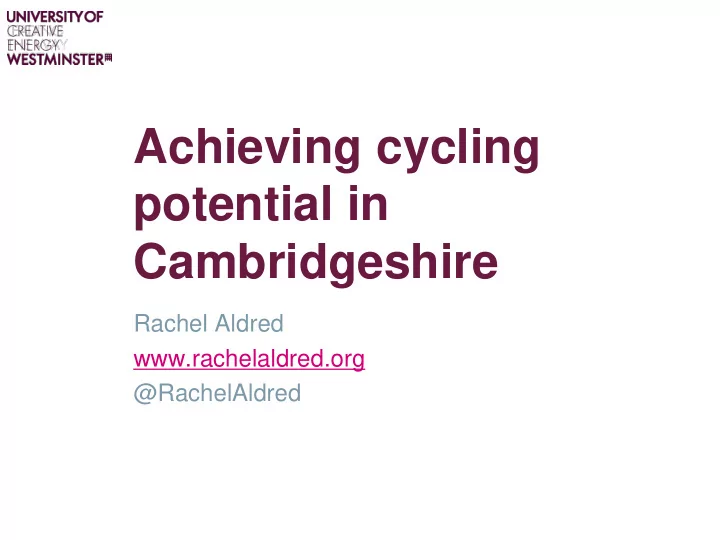

Achieving cycling potential in Cambridgeshire Rachel Aldred www.rachelaldred.org @RachelAldred
Content – Cycling potential in Cambridgeshire – Achieving cycling potential – Ensuring wider participation
Cycling and Cycling Potential – Cambridgeshire currently v high cycling for UK – But still potential for substantial increases
‘Go Dutch’ and ‘e - bike’ scenarios
Commuter cycling potential, e-bike scenario NB does not take account of cycling potential derived from completely new routes
Cambridgeshire potential (1)
Cambridgeshire potential #2
Cambridgeshire potential #3
Cambridgeshire potential #3
Cambridgeshire potential #4
Cycling potential #5
Building for that potential
The role of near misses (primarily with motorised users) in deterring cycling Type of Incident Rate per year, regular UK commuting cyclist Death .000125 (once every 8,000 yrs) Reported serious injury .0025 (once every 400 yrs) Reported slight injury .015 (once every 67 yrs) Any injury (reported or not) .05 (once every 20 yrs) Harassed/abused 20 ‘Very scary’ incident 60 Any non-injury incident 450 Final three figures derived from Near Miss Project data. First four derived from published academic sources – see Aldred and Crosweller (2015) for full details.
Safe and Subjectively Safe – ‘a broad academic consensus that most people prefer to cycle away from motor traffic, or in environments with low levels of motor traffic’ (Aldred 2015: EJTIR http://www.tlo.tbm.tudelft.nl/fileadmin/Faculteit/TBM/Onderzoek/EJTIR/Back_issues/15.2/2015_02_00.pdf ). • Includes 2 detailed and particularly relevant TfL studies, my own recent UK study – Increasing evidence that ‘build it and they will come’ – Obvious immediate growth e.g. in London – High quality academic studies including from Cambridge e.g. http://discovery.ucl.ac.uk/1476446/
Realising the benefits: Gold Standard Infrastructure Direct routes… • Away from motor traffic • Physically protected infrastructure (tracks) on busier roads • Very lightly trafficked smaller streets
Widening participation – Cambridgeshire E.g.: Cambridge resident commuters doing well at this with a disability limiting – But need to ensure day-to-day activities this continues as cycling grows – Cf. results from Rachel Aldred, James Woodcock & Anna Goodman (2016) Does More Cycling Mean More Diversity in Cycling?, Transport Reviews, 36:1, 28-44, DOI: Public transport Car 10.1080/01441647.2015.1014451 Bicycle On foot Other
Direct routes increase wider participation – If a quieter route creates a detour such that a 2 mile trip becomes effectively a 3 mile trip, younger men’s propensity to cycle the route will decrease 11%. – But for younger women, the decline is 19%, and for older adults (60+) the propensity would decrease by 35%. Photo of Betty by Kat Jungnickel
Subjectively safe routes widen participation Gender and preferences for separated infrastructure 3,500 3,000 Women's preferences 2,500 are stronger 2,000 1,500 No 1,000 differences found 500 0 Cycling provision separated from motor traffic: a systematic review exploring whether stated preferences vary by gender and age R Aldred, B Elliott, J Woodcock, A Goodman, Transport Reviews
Subjectively safe routes widen participation Cyclist gender and infrastructure (Camden study) Female No Yes Total Protected No Count 2056 671 2727 cycle lane? % 75% 25% 100% Yes Count 1084 550 1634 % 66% 34% 100 % Total Count 3140 1221 4361 % 72% 28% 100% Source: paper co-authored with John Dales, under second stage peer review (based on research report for London Borough of Camden)
Key points – Lots of potential still to increase cycling in Cambridgeshire – PCT and other analysis can help identify key areas and routes – Diversity of cyclists currently good; need to maintain this – Key is direct and subjectively safe routes
Achieving cycling potential in Cambridgeshire Rachel Aldred www.rachelaldred.org @RachelAldred
Recommend
More recommend